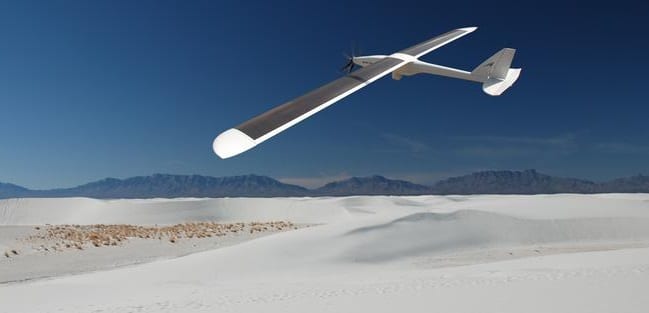Ascent Solar Technologies has announced that the company has successfully developed and shipped its next-generation laminated aerospace product, using Ultralight technology. The Ultralight PV module represents a major breakthrough over its existing Superlight technology in terms of weight and performance for ready-to-integrate PV modules for aerospace applications, such as high-altitude unmanned aircraft.
The Ultralight PV module is the first of its kind for Ascent Solar to introduce two major advances over previous products. First, Ultralight utilizes next-generation PV that was developed originally for Ascent’s space customers and is manufactured on a substantially thinner substrate than Ascent’s standard bare PV module. Secondly, the product utilizes asymmetric laminate packaging to reduce thickness and weight substantially from its predecessor, the Superlight product. These changes have resulted in vastly-reduced areal density to nominally 330 grams per square meter, or approximately 50% less than ‘thin’ crystalline PV airship options. Nominal specific-power under terrestrial (AM1.5) lighting is 280 watts per kilogram and projected to exceed 330 watts per kilogram in near-space conditions (AM0). The PV modules that were provided to the customer in this first shipment are designed for easy integration to reduce assembly time of the power system and increase overall array reliability.
“We are proud to provide our new Ultralight flexible laminated solar blankets to our customer for their airship,” stated Dr. Joseph Armstrong, Chief Technology Officer and founding member of Ascent Solar. “Our company was created, in part, to address the emerging unmanned high-altitude airship market through the use of our unique, extremely light and flexible photovoltaic product, and we have customizable solar blankets that address multiple aspects of this unique market segment. The customer has ordered a custom version of one of our existing 25-watt Superlight airship PV blankets with dimensions and electrical connections specific to their vehicle. By combining our space PV technology with our new asymmetric laminate packaging, we were able to achieve the breakthrough in terms of substantially higher power-to-weight ratio with Ultralight. Furthermore, our proficiency at rapid prototyping and concurrent design for manufacturability allowed us to accept this custom order with a swift turnaround time to delivery. By proving out the Ultralight construction, we have opened the door for other customers who wanted an even lighter version of our aerospace product that cover drones, tethered aerostats, and both fixed-wing and lighter-than-air high-altitude long-endurance (HALE) applications.”
“We are thrilled to have completed this significant order,” said Victor Lee, President and CEO of Ascent Solar. “This contract, which accounted for approximately 50% of our 2017 full-year revenue, will be booked as revenue in the first quarter and give the Company a strong head start into 2018. This is not only significant in value but also underscores the power of Ascent’s proprietary technology to address these rapidly emerging and growing premium PV markets. We hope that this contract is only the ‘tip of the iceberg’ as the airship project, when successfully launched, is expected to be rolled out on a much larger scale in the near future. Our technical team has been working with our aerospace customer to identify the best solution for their needs while providing a product that takes full advantage of the key attributes of our monolithically-integrated flexible CIGS PV.”
The post Ascent Solar Develops Ultralight Thin-Film Modules for High-Altitude Unmanned Aircraft appeared first on Unmanned Systems Technology.
